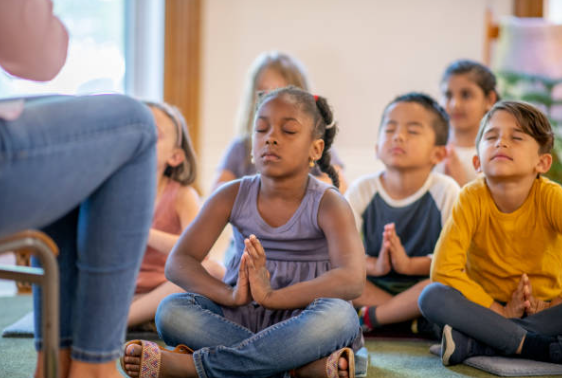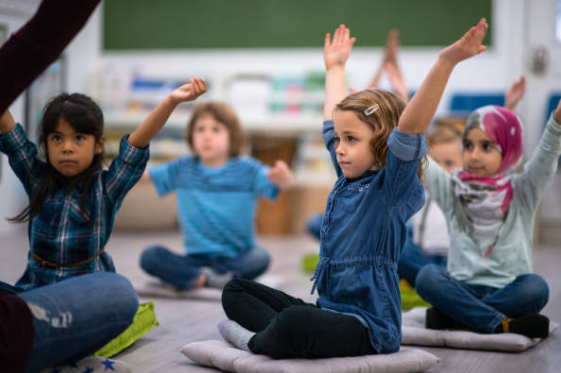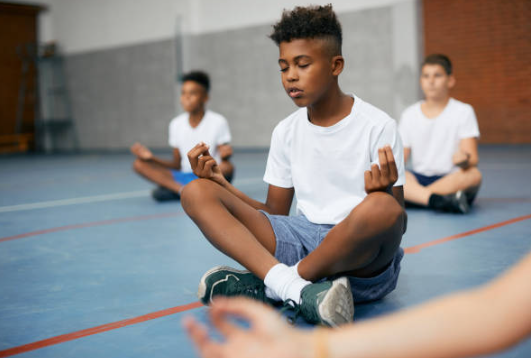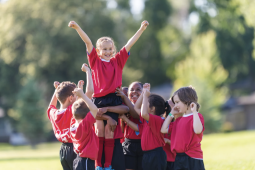Educating Today’s Children Through the Lens of Mindfulness

Previously published in Volume 83, Issue 1
Abstract
Many of today’s students are experiencing higher levels of stress and anxiety in school. The need for competitive grades, the desire to be seen as perfect in a digital society, and parental pressures are only some of the reasons that students are experiencing more stress. This increased stress has lead to higher levels of stress and anxiety for many adolescents. This article explores the beginning of how students may learn to calm and control their stressors and anxiety through mindfulness training. Several examples of mindfulness training in different classroom scenarios are introduced, and the relationships between our connections to everything around us are explored. The article serves to provide a starting point for educators who may feel at a loss for how to help their students manage their stress and anxiety levels.
Many students today are more anxious than ever for their perceived need to be smarter, wiser, and overall ‘better’ than everyone else. Higher expectations in academics, leadership skills, and pressure from parents to gain entrance into post-secondary institutions are leaving many students with little time to just be kids.
What are today’s adolescents missing out on as they constantly push and rush forward, without taking the time to appreciate where they are, who they are, and what they have experienced? Jardine notes that even in education we are “so caught up in this senseless roar and rush” (1999, p. 263) as parents, coaches, and students themselves demand better results, faster learning, and higher grades. We no longer have the ability or time to teach a curriculum of caring, instead focusing on “learning for skill and financial success” (Moore, 2005, p. 13) which are “relevant to the ego, but they obscure the needs of the soul” (p. 13).
How can we teach students to nourish the needs of their soul? What does the soul really need? Many educators feel ill-prepared to teach students about mindfulness, creating connections, and an overall curriculum of caring.
Undergraduate teacher preparation programs across Canada and the USA rarely include courses of study that focus on these practices and even general health education courses are far too rare in most post-secondary teacher preparation programs. (Lechtenberger, Mullins, & Greenwood, 2008; Manion, Short, & Ferguson, 2012; Walter, Gouze, Cicchetti, Arend, Mehta, Schmidt, & Skvarla, 2011).
This article examines the importance of mindfulness, how educators can begin to teach students about a curriculum of caring by working to calm their anxiety through mindfulness and simple breathing techniques. We'll also consider how these techniques can be used to create connections between the mind and body, and how these practices will help students experience their present condition more fully.
Connecting to the whole child
As noted above, our society has become a fast-paced environment where we are never content with our current situation and always seem to be striving for “more.” The practice of Buddhism believes that there are three poisons that corrupt our heart-mind: desire, hatred, and ignorance (Park & Song, 2005). If we can rid ourselves of these three poisons, we return to our original state of harmony, our basic goodness. Instead, we continue to feed our ‘hungry ghosts’ (Bai, 2012), our ego and needs, though we are never satiated with what we have.
As teachers, we need to focus on our “integrity and dignity, wisdom and compassion” (Bai, 2012, p. 320) to create a ‘curriculum of caring.’ Focusing on our connection to each other will help with this. Our lack of connection can be seen through the current levels of cyber-bullying occurring online. Many people feel comfortable typing rude or disrespectful comments to a screen, but would never consider saying the same thing directly to another person. Even the small connection of being face to face with another person and seeing the reaction of that person is enough to make people reconsider their words. As we begin to realize and develop our connections to others, we “naturally [practice] humility, compassion, care and generosity” (Bai, 2008, p. 113).

Connectedness, inclusion and balance
Miller (2005) describes three basic principles of holistic education: connectedness, inclusion, and balance. Connectedness refers to facilitating connections throughout our educational experiences. Inclusion seeks to engage all students and teach them in a manner that they can understand. Balance recognizes the complementary forces in nature, and encourages educators to provide for both forces.
The example of such forces given by Miller (2005) describes our push for rational thinking and individual competition in a classroom, instead of looking to teach attitudes of intuition and cooperation. Our current education system is set up to encourage this competition for entry into specialized post-secondary programs, University degrees, and professional vocations. Awards are given to the top students at the end of each school year. What would our classroom look like if we focused instead on the achievements of every student?
The lack of connection with their school that many students experience, coupled with a system that caters primarily to the student who can learn through standard teaching methods and an environment of competition, has created highly stressful situations for many students. Even those who are successful in this environment continue to feel anxiety in trying to stay at the top.
How can mindful practice reduce this anxiety and help create a connected, inclusive and balanced classroom? Will these practices calm the minds of our students, teaching them to “take care and consideration and [pay] deep attention to what [they] are doing” (Jardine, 1999, p. 272)?
Mindfulness, awareness and identifying anxiety
While mindful practice is often considered in conjunction with Eastern practices, it has recently moved into our mainstream classrooms. It is often used in place of meditation, though it encompasses more than just breathing techniques. Mindfulness involves “consciously bringing our awareness to the present moment – to the here-and-now experience” (Gardner & Grose, 2015, p. 35). It aims to recognize and accept our feelings and emotions non-judgementally (Gardner & Grose, 2015). It is “being in the moment; focusing upon the action – even the action of holding stillness – and finding a deep appreciation for whatever it is” (Francis & Lu, 2009, p. 24). Bai describes a ‘stop’ in the practice of mindfulness, “where the automaticity of thought comes to a halt and gives away to an embodied awareness” (2015, p. 140). Bellin (2015), and cites Brach in offering a basic mindful practice described by the acronym RAIN. As the practitioner becomes more aware of their current emotion or feeling, they are encouraged to:
- Recognize the presence of the emotion or feeling, and label it if necessary
- Allow the emotion or feeling to be fully experienced as it occurs
- Investigate the emotion or feeling with curiosity and kindness, while understanding how it can change
- Non-identify the emotion or feeling, releasing it again and again until the emotion has lost its hold over the practitioner.
Bigdeli and Bai (2009) offer a similar thought in that mindfulness allows a person to identify and understand their anxiety better. In identifying situations that cause anxiety and the reaction to these situations, mindful practice, as noted by Bellin (2015), allows a person to self-reflect on his/her response to the anxiety, offering the opportunity to manage his/her response to the situation.
If we are mindfully aware of the situation, we can react and respond to it in a positive manner. Bigdeli and Bai (2009) are also quick to point out that anxiety can be a positive and healthy emotion. It is only when stress and anxiety are the constant driving force behind our actions that it becomes a negative and destructive force (Bigdeli & Bai, 2009; Moore, 2005).
Mindfulness becoming mainstream
As evidenced through local Comprehensive School Health group discussions, mindfulness practice is becoming mainstream in many classrooms within the Edmonton Catholic school district, often helping students in younger grades reduce anxiety levels before a big test, lessen incidences of bullying, or to help calm a hyperactive class (Leland, 2015). Anxiety, which is often caused by a lack of connection, a feeling of inadequacy, or a loss of control, (Haubrich, 2016) is the first mental health disorder to appear in young children (Neil & Christensen, 2009, p. 209; Haubrich, 2016). As young children do not yet have the mental capacity for reasoning, they are often unable to understand and cope with their anxiety when it strikes.
In looking at methods of mindful breathing or meditation, there are numerous websites and apps that can be easily used in a classroom or at home to help teach children mindful breathing techniques that can be used to help them regain control and stop their feeling of inadequacy in managing their anxiety. One example; www.stopbreaththink.org offers guided breathing audio clips, ranging from three minutes to 20 minutes, which encourage the practice of mindful thought in the present. Teachers may use this program as part of their morning routine, preparing students to learn for the day, or at a point in their class where students need to calm their anxieties or hyperactivity.
Allowing three to five minutes of mindful practice before an exam may help calm the anxieties of some students, allowing them to clear their minds before beginning the test, or calm themselves after a period of high intensity. With the ‘StopBreathThink’ app, students are asked to sit, close their eyes and focus on their breathing. They feel the chair under them, the floor under their feet, all the while, guided through relaxed breathing. Students emerge from the meditative process with a calmer mind and a connection to the present and being more ready and able to learn.

Another application titled ‘Calm’ offers seven-day meditative sessions, sleep stories for adults and children, and a timed breathing app, where users are instructed to inhale, hold and exhale their breath in time with a circular timer. Similar to the use of a Hoberman Sphere, this circular breathing timer can help children and adolescents learn to calm and control their breathing, giving them a visual cue to follow while feeling anxious or stressed.
Shaprio, Lyons, Miller, Butler, Vieten and Zelazo (2015) have compiled a comprehensive list of mindfulness programs, such as iRest for Kids, MindUp, Learning to Breath, Wellness Works in Schools and Little Flower Yoga, along with brief descriptions about the program, their implementation, and the goals of the program, that may be further explored.
Simplicity, oneness and interdependency
Articles are now beginning to appear more frequently on the use of mindful practice in the classroom, though teachers must remember that as “mindfulness is based upon now, mindful teachers stress the process as much as the product” (Francis & Lu, 2009, p. 24). In describing mindfulness practice in a physical education setting, Francis and Lu (2009) remind us to focus on simplicity, oneness and interdependency when introducing mindful practice.
Simplicity focuses on the idea that less is more. Trying to achieve more to impress others will not help in the practice of mindfulness. Instead, students should allow a phenomenon to just be. It should not be judged as good or bad, but just as it is. This is a difficult concept to operationalize in a competitive sport environment or physical education classroom, yet teachers should strive to understand all movement as beautiful, just for being movement itself, a very aesthetic notion.
Oneness recognizes that everything in the universe is connected and inseparable. We must maintain a balance with our connections to ensure that all children involved stay healthy. In a physical education classroom, this involves paying attention to our bodies and our thoughts to ensure that we do not cause them harm in trying to achieve something more. Here, a positive attitude towards all physical activity is promoted, instead of focusing on specific skills, or non-inclusion of students through competitive games.
Interdependency recognizes that all of our actions will have some effect on those around us. In a physical education setting, students should be encouraged to work cooperatively and collaboratively rather than focusing on competition between individuals. Thinking back to Miller’s (2005) idea of creating a classroom that focuses on connections, inclusion and balance, the ideas put forth here by Francis and Lu (2009) echo those of Miller. Oneness focuses on including students who may not feel welcomed in a physical education setting, while interdependency helps to create connections through balance.
Simplicity here helps to stem the feelings of competitiveness between classmates in stressing the importance of enjoying the activity simply as it is. Instead of pushing for a competitive, skill-based approach to Physical Education, students should be encouraged to participate for the sheer joy of movement and being physically active, as exemplified in the Alberta Physical Education curriculum where students are encouraged to ‘Do it Daily…For Life!’ (Alberta Education, 2000). They should try to remain in the moment of their activity, focusing on the “joy of a movement sensation” (Francis & Lu, 2009, p. 24), or on the feeling of their heart beating faster at the end of a class.
Another simple example is to save instruction until after students have completed a warm-up and stretch (Francis & Lu, 2009). Many teachers will give instruction during a warm-up stretch, not allowing students the time to listen to their bodies as they stretch or move, and enjoy the feeling of sinking further into their personal movement. While these examples are situated in a physical education setting, these three ideas of oneness, interdependency and simplicity can be easily applied to any classroom scenario.
Creating connections through mindful practice
How does this practice calm our anxiety and create connections to others? As discussed, mindful breathing practices helps slow the breathing of the individual. As a student is asked to recognize feelings and thoughts, experience them and release them away from themselves, mindfulness helps to calm the racing thoughts of their anxiety and stress. Students are able to identify their thoughts, acknowledge them, and release them so that they no longer weigh heavily on their minds.
This awareness of emotion and thoughts also helps to stem feelings of anxiety. Students can focus calmly on their stressors and clearly reflect on how they should react to the situation. This practice allows students to better manage their anxiety around testing situations or due to stressors outside of their school lives, giving them the skills to instead focus on their learning rather than their anxieties.
As previously noted, one major cause of stress is a lack of connection (Bigdeli & Bai, 2009; Haubrich, 2016). Children feel isolated because they do not know how to handle a situation and believe they have nobody to help them through it. Calm and mindful practice not only allows them to logically work through a problem, but they are also better able to relate their current situation back to previous situations they may have already experienced, offering solutions that are not apparent during a worked up state of crisis. Students are also able to connect with others and their environment on a deeper level as they become more deeply connected with the experience.
Mindful practice has been shown to help build interpersonal skills (Broderick & Frank, 2014), helping them develop stronger connections to those around them, both peers and teachers. Bai and Scutt note that mindfulness “connects, integrates, and transfuses everything” (2009, p. 101), and our practice of mindfulness opens our hearts to wonder and gratitude. As we begin to experience this wonder more mindfully, in the present, we are now stopping the “senseless roar and rush” (Jardine, 2009, p. 263) and beginning to fully appreciate things around us. Once we can understand that “any object, even the most trivial of things, is in the center of this interdependency, with all things ordered around it” (Jardine, 2009, p. 265), it becomes much harder to react in a negative manner towards it. In accepting things as they are, we have a better chance of understanding them. Thus begins our connection to ourselves and the people around us.
Barriers to mindful practice
Educators may run into several barriers towards mindful practice. These include the lack of teacher training and courses offered in Health Education in post-secondary institutions, (Basch, 2011; Lechtenberger, et al., 2008; Manion et al., 2012; Walter et al., 2011), the need for strong administrative support (Mendelson, Dariotis, Feagans Gould, Smith, Smith, Gonzalez & Greenberg, 2013), and an unwillingness to participate from some students. However, “[h]ealthier students are better learners” (Basch, 2011, p. 651), and programs rooted in mindfulness training can help students be healthier, leading to higher levels of learning and achievement. As an educator must have “commitment and familiarity with mindfulness skills” (Mendelson, et al., 2013, p. 280) to ensure success of a mindfulness based program, it is imperative that all educators receive some form of pre-service teacher training in the area of Health Education, mental well-being and mindfulness. This training also ties in with allowing students to understand and form connections with themselves, those around them, and their surrounding world.
As well, the need for time, space and support are vital to the success of these programs, and school administrators are often focused solely on the measurable indicators of student achievement rates in the areas of literacy and numeracy.
Mindfulness in practice
Smith-Carrier, Koffler, Mishna, Daciuk and Zeger (2015) found that mindfulness training provided by the Mindfulness Ambassador Council (MAC) in Toronto aided students in reducing their stress and anxiety, improved their executive functions, helped them to regulate their emotions, build interpersonal skills and promoted their inner well being. Not only did the MAC aid students in calming anxiety, students built connections with those around them. This reduction of stress and anxiety, and the promotion of positive relationships with those around them can lead to a stronger learning environment for students, and to a reduction in behavioural issues in the school environment, allowing for higher levels of learning for all students (Beauchemin, Hutchins & Patterson, 2008; Franco, Mañas, Cangas & Gallego, 2010; Smith-Carrier et al., 2015).
Several students did express difficulties with the MAC program, ranging from the breathing exercises being too long and boring to an unwillingness to express their feelings with other students (Smith-Carrier et al., 2015). Younger students may not understand the purpose of each action, such as closing their eyes (Smith-Carrier et al., 2015). By offering different sessions for students, consisting of different time frames, the option of sharing the experience with others or keeping it private, and embedding this practice into the learning environment at a young age, educators can make the practice of mindfulness a habit practiced by students from an early age. Explanations of actions to younger and older students both can encourage participation through understanding and educators themselves will reap the benefits of this practice on their own stressful lives as they continue their practice at the same time (Roeser, Skinner, Beers & Jennings, 2012).
Conclusion
As our society becomes ever more competitive and generally stressed and we continue to race forward as fast as we can, we need to remember to take time to enjoy our present experiences as they are. Our personal need for success and our desire to feed our own ego do little to move us forward. Instead, we are left feeling tired, anxious and strained as our overall health deteriorates.
The practice of mindfulness will allow us to slow our minds and focus on enjoying the present. As well, through our thoughtful exploration of these moments, we are able to connect more intimately with the people and environment around us, strengthening our personal well-being. Teaching mindful practice in our schools will instil this calming effect on students’ minds, teaching them the skills required to understand and manage their anxiety and stress. This reduction in anxiety and stress allows students to focus on their present, enabling them to be better learners who are more focused and engaged in their learning.
Additionally, this practice will reinforce their connections to others, improving their inter-personal relationships with other students and their teachers within their school. Through mindfulness practices, students will be better able to understand their relationships with others and how their actions may have an impact on others. This will lead to a stronger connection between students and their school community, and also to a better understanding of our similarities and our differences, helping everyone to create a more positive global community.
References
Alberta Education (2000). Physical Education Program of Studies. Retrieved from: https://education.alberta.ca/media/160191/phys2000.pdf
Bai, H. (2008). Out beyond the ideas of wrongdoing and rightdoing… Complicity: An International Journal of Complexity and Education 5(1), 109-114. Retrieved from http://eds.a.ebscohost.com/eds/pdfviewer/pdfviewer?vid=18&sid=1249b5a3-3a7b-4a23- aa9c-82732de7bd13%40sessionmgr4005&hid=4113
Bai, H. (2012). Reclaiming our moral agency through healing: A call to moral, social, environmental activists. Journal of Moral Education 41(3), 311-327. http://dx.doi.org/10.1080/03057240.2012.691628
Bai, H. (2015). Peace with the earth: Animism and contemplative ways. Cultural Studies of Science Education 10(1), 135-147. http://dx.doi.org/10.1007/s11422-013-9501
Bai, H., & Scutt, G. (2009). Touching the earth with the heart of enlightened mind: The Buddhist practice of mindfulness for environmental education. Canadian Journal of Environmental Education 14(1), 92-106. Retrieved from http://eds.a.ebscohost.com/eds/pdfviewer/pdfviewer?vid=20&sid=1249b5a3-3a7b-4a23-aa9c-82732de7bd13%40sessionmgr4005&hid=...
Beauchemin, J., Hutchins, T. L., & Patterson, F. (2008). Mindfulness meditation may lessen anxiety, promote social skills, and improve academic performance among adolescents with learning disabilities. Complimentary Health Practice Review 13(1), 34-45. http://dx.doi.org/10.1177/1533210107311624
Bellin, Z. J. (2015). The meaning connection between mindfulness and happiness. Journal of Humanistic Counseling 54, 221-235. http://dx.doi.org/10.1002/johc.12013
Bigdeli, S., and Bai, H. (2009). The triunal model of anxiety and its application to anxiety reduction in learning and teaching environments. TESL Canada Journal 27(1), 103-114. http://dx.doi.org/10.18806/tesl.v27i1.1029
Broderick, P. C., & Frank, J. L. (2014). Learning to BREATHE: An intervention to foster mindfulness in adolescents. New Directions for Youth Development 142, 35-46. http://dx.doi.org/10.1002/yd.20095
Francis, N., & Lu, C. (2009). The conceptual framework of the Eastern approach in physical education: Ancient wisdom for modern times. ACHPER Healthy Lifestyles Journal 56(2), 23-27. Retrieved from dce43119ffc7@sessionmgr4001&hid=4211&preview=false
Franco, C., Mañas, I., Cangas, A. J., & Gallego, J. (2010). The applications of mindfulness with students of secondary school: Results on the academic performance, self-concept and anxiety. Knowledge Management, Information Systems, E-learning, and Sustainability Research 111. http://dx.doi.org/10.1007/978-3-642-16318-0_10
Gardner, P., & Grose, J. (2015). Mindfulness in the academy – transforming our work and ourselves ‘one moment at a time’. Collected Essays on Learning and Teaching 8, 35-46. Retrieved from http://files.eric.ed.gov/fulltext/EJ1069707.pdf
Haubrich, A. (2016). Hurried and worried: Understanding elementary anxiety. Conference session from the Greater Edmonton Teachers Convention Association.
Jardine, D. (1999). A bell ringing in the empty sky. In W. F. Pinar (Ed.), Contemporary curriculum discourses: Twenty years of JCT (262-277). New York: Peter Lang.
Lechtenberger, D., Mullins, F. E., and Greenwood, D. (2008). Achieving the promise: The significant role of schools in transforming children’s mental health in America. Teaching Exceptional Children 40(4), 56-64. Retrieved from http://eds.a.ebscohost.com/eds/pdfviewer/pdfviewer?vid=29&sid=b102b874-ae66-4174-a141-1ad25eb764d6%40sessionmgr4005&hid=4211
Leland, M. (2015). Mindfulness and student success. Journal of Adult Education 44(1), 19-24. Retrieved from: http://search.proquest.com.login.ezproxy.library.ualberta.ca/cv_734690/docview/1709527310/fulltextPDF/741D5016D364492FPQ...
Manion, I., Short, K. H., & Ferguson, B. (2012). A snapshot of school-based mental health and substance abuse in Canada: Where we are and where it leads us. Canadian Journal of School Psychology 28(1), 119-135. https://doi.org/10.1177/0829573512468847
Mendelson, T., Dariotis, J. K., Feagans Gould, L. Smith, A. S. R., Smith, A. A., Gonzales, A. A., & Greenberg, M. T. (2013). Implementing mindfulness and yoga in urban schools: A community-academic partnership. Journal of Children’s Services 8(4), 276-291. http://dx.doi.org/10.1108/JCS-07-2013-0024
Miller, J. P. (2005). Holistic learning. In J. P. Miller, S. Karsten, D. Denton, D. Orr, & I. C. Kates (Eds.), Holistic Learning and spirituality in education: Breaking new ground (1-6). Albany: State University of New York Press. Retrieved from: http://eds.b.ebscohost.com/eds/detail/detail?nobk=y&vid=6&sid=ff4bd527-6a8b-4ef4-a8b4-8d926055886e@sessionmgr110&hid=126&bdata=JnNpdGU9ZWRzLWxpdmUmc2NvcGU9c2l0ZQ==#AN=145004&db=e000xna
Moore, T. (2005). Educating for the soul. In J. P. Miller, S. Karsten, D. Denton, D. Orr, & I. C. Kates (Eds.), Holistic Learning and spirituality in education: Breaking new ground (9-15). Albany: State University of New York Press. Retrieved from http://eds.b.ebscohost.com/eds/detail/detail?nobk=y&vid=6&sid=ff4bd527-6a8b-4ef4-a8b4-8d926055886e@sessionmgr110&hid=126&bdata=JnNpdGU9ZWRzLWxpdmUmc2NvcGU9c2l0ZQ==#AN=145004&db=e000xna
Neil, A. L., & Christensen, H. (2009). Efficacy and effectiveness of school-based prevention and early intervention programs for anxiety. Clinical Psychology Review 29, 208-215. doi:10.1016/j.cpr.2009.01.002
Park, Y., & Song, M. (2005). Won Hyo’s One Heart-Mind and Meditation on One Heart-Mind as Part of Holistic Education. In J. P. Miller, S. Karsten, D. Denton, D. Orr, & I. C. Kates (Eds.), Holistic Learning and spirituality in education: Breaking new ground (109-116). Albany: State University of New York Press. Retrieved from http://eds.b.ebscohost.com/eds/detail/detail?nobk=y&vid=6&sid=ff4bd527-6a8b-4ef4-a8b4-8d926055886e@sessionmgr110&hid=126&bdata=JnNpdGU9ZWRzLWxpdmUmc2NvcGU9c2l0ZQ==#AN=145004&db=e000xna
Roeser, R. W., Skinner, E., Beers, J., & Jennings, P. A. (2012). Mindfulness training and teachers’ professional development: An emerging area of research and practice. Child Development Perspectives 6(2), 167-173. http://dx.doi.org/10.1111/j.1750-8606.2012.00238.x
Shaprio, S. L., Lyons, K. E., Miller, R. C., Butler, B., Vieten, C. & Zelazo, P. D. (2015). Contemplation in the classroom: A new direction for improving childhood education. Educational Psychology Review 27, 1-30. http://dx.doi.org/10.1007/s10648-014-9265-3
Smith-Carrier, T., Koffler, T., Mishna, F., Wallwork, A., Daciuk, J., & Zeger, J. (2015). Putting your mind at ease: Findings from the Mindfulness Ambassador Council programme in Toronto area schools. Journal of Children’s Services 10(4), 376-392. http://dx.doi.org/10.1108/JCS-10-2014-0046
Walter, H. J., Gouze, K., Cicchetti, C., Arend, R., Mehta, T., Schmidt, J., & Skvarla, M. (2011). A pilot demonstration of comprehensive mental health services in inner-city public schools. Journal of School Health 81, 185-193. http://dx.doi.org/10.1111/j.1746-1561.2010.00578.x









